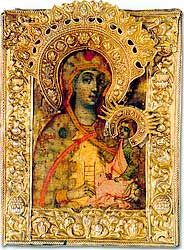The Russian Icon
By the time Russia embraced Christianity through the Eastern Orthodox Church, the theology was already highly developed. Russia took the highly developed theology and enthusiastically embraced its conclusions without necessarily absorbing its rationale. The result was a somewhat unorthodox Russian Orthodox Church. They produced some wild saints and some unique phenomena (one of my favorites, those men who sacrificed all things, including their reason, for the sake of God: the "holy fool," yourodivyje, like Nicholas of Pskov, who rebuked Ivan the Terrible by slapping a piece of bloody raw meat in his hands).
Anyway, the NY Times reports this morning that the restoration of Russian Orthodox icons is flourishing. That's great to hear.
Since the fall of atheistic Communism in 1991, the painting and restoring of icons has flourished again in Russia, and old icons that had been hidden or neglected have accumulated in need of restoration.
"Now, everywhere," said Ksenia Pokrovsky, a Russian iconographer who now lives near Boston - "everywhere, in all Russian towns and cities, there are both restorers and iconographers. Thousands of them. It is like a new spring."
Sometimes the restorers rediscover forgotten creations of great masters that have been obscured by the layer of boiled linseed oil that was used instead of varnish and that turns dark after 70 or 100 years.
Often the great icons have been painted over with as many as six layers of newer icons as the board is reused over the centuries. The layers are gently removed and can even be separately preserved if they are valuable.
Sometimes a completely unexpected, anonymous masterpiece is discovered beneath the grime and overpainting and joins the body of great Russian art.
If you want a good introduction to iconography, see Michael Quenot's The Icon: Window on the Kingdom. It's published by St. Vladimir's Seminary Press (a Russian Orthodox publisher).

